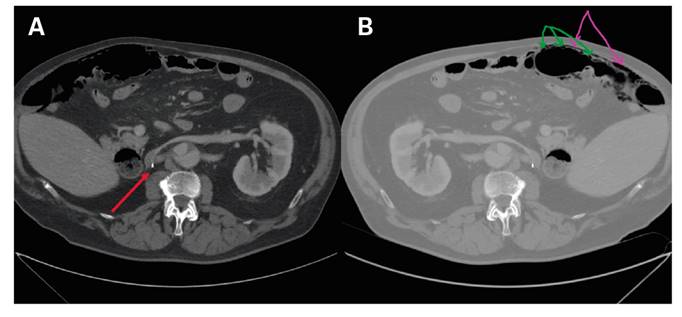Mi SciELO
Servicios Personalizados
Revista
Articulo
Indicadores
-
 Citado por SciELO
Citado por SciELO -
 Accesos
Accesos
Links relacionados
-
 Citado por Google
Citado por Google -
 Similares en
SciELO
Similares en
SciELO -
 Similares en Google
Similares en Google
Compartir
Revista Española de Enfermedades Digestivas
versión impresa ISSN 1130-0108
Rev. esp. enferm. dig. vol.110 no.8 Madrid ago. 2018
https://dx.doi.org/10.17235/reed.2018.5588/2018
LETTERS
A pneumoperitoneum due to intestinal cystic pneumatosis associated with a tyrosine kinase inhibitor
1Servicio de Aparato Digestivo. Hospital Campus de la Salud de Granada. Granada, Spain
2Servicio de Radiodiagnóstico. Hospital General Universitario de Ciudad Real. Ciudad Real, Spain
3Servicio de Medicina Interna. Hospital Virgen de Altagracia. Manzanares, Ciudad Real, Spain
Key words: Intestinal pneumatosis; Pneumoperitoneum. Molecular therapy; Bowel toxicity; Tyrosine kinase
Dear Editor,
Pneumatosis cystoides intestinalis is characterized by multiple air-filled cysts in the intestine wall. Recently, antitumor molecular targeted therapies have been associated with bowel perforation and the development of secondary pneumoperitoneum.
Case report
We present the case of a 72-year-old male that had undergone a right nefrectomy due to a renal cell carcinoma in 2010. He was currently receiving chemotherapy for lung metastasis (pazopanib, a tyrosine kinase inhibitor). A computed tomography (CT) scan showed air-filled cysts in the right colon wall, which was suggestive of an intestinal cystic pneumatosis. Furthermore, import free air was also present due to secondary pneumoperitoneum (Fig. 1). The patient presented to the Emergency Department. However, due to the absence of symptoms, clinical peritonitis or analytical impact, an observational control with a liquid diet therapy and intravenous antibiotics was performed. The patients' course was favorable, and a radiologic examination ten days later showed that the condition had been resolved. After medical discharge, treatment with nivolumab was started, as a substitute to pazopanib.
Discussion
Pneumoperitoneum secondary to intestinal pneumatosis is an unusual complication and often has minimal clinical repercussions. Its etiology seems to be multifactorial and is thought to be a sign of bowel toxicity with antitumor therapy. Recently, De la Serna et al. reported the association with cytostatic and molecular targeted therapies (bevacizumab) 1. Tyrosine kinase inhibitors are another pharmacological group that are associated with this complication 2,3. In the majority of cases, pneumoperitoneum secondary to cystic pneumatosis does not require surgical treatment at first and can be managed conservatively. The presence of intestinal pneumatosis during treatment for cancer is difficult to interpret. Therefore, it is important to establish any relationship with clinical findings 4. The evolution described in the literature is variable and the effect of these drugs is inexplicable.
Bibliografía
1. De la Serna S, Luna A, De la Rosa H. Neumatosis intestinal y neumoperitoneo en contexto de tratamiento oncológico: un cambio de actitud. Rev Esp Enferm Dig 2018:110(1):68-9. [ Links ]
2. Shinagare A, Howard S, Krajewski K, et al. Pneumatosis intestinalis and bowel perforation associated with molecular targeted therapy: an emerging problem and the role of radiologists in its management. AJR Am J Roentgenol 2012;199(6):1259-65. DOI: 10.2214/AJR.12.8782 [ Links ]
3. Flaig TW, Kim FJ, La Rosa FG, et al. Colonic pneumatosis and intestinal perforations with sunitinib treatment for renal cell carcinoma. Invest New Drugs 2009;27(1):83-7. DOI: 10.1007/s10637-008-9146-z [ Links ]
4. Choi YA, Sim EH, Lee KE, et al. A case of pneumatosis intestinalis associated with sunitinib treatment for renal cell carcinoma. Korean J Gastroenterol 2013;61(6):347-50. DOI: 10.4166/kjg.2013.61.6.347 [ Links ]











 texto en
texto en 



